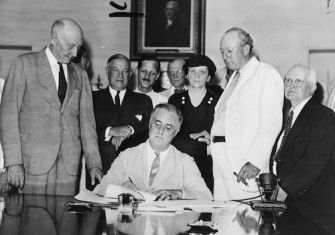'Give Us Roosevelt' - Workers and the New Deal Coalition
Bruce Nelson traces how the magic of FDR and his practical social programmes welded American labour to the Democratic Party, and discusses the tensions that eventually weakened that union.
Nearly forty-five years after his death, Franklin D. Roosevelt's reputation as one of the greatest vote-getters in the history of American politics remains intact. His smashing victory over Alf Landon in 1956 marked not only the zenith of his own popularity and power but a decisive step in the major political realignment that made the Democrats the nation's majority party after nearly forty years of Republican dominance. Although FDR attracted support from many sectors of the population, workers constituted the heart of the Roosevelt coalition.
Before the 1930s American workers had seldom if ever voted as a bloc at the national level. Cultural, ethnic, and racial divisions had driven them into different electoral camps. However, an erratic but increasingly persistent trend toward a more unified labour vote had begun developing early in the twentieth century. By 1928, the votes of urban, foreign-stock, and largely working-class voters for the Democrat Al Smith had provided a clear harbinger of the realignment that would become evident with Roosevelt's defeat of Herbert Hoover in 1932 and would solidify during his presidency.







